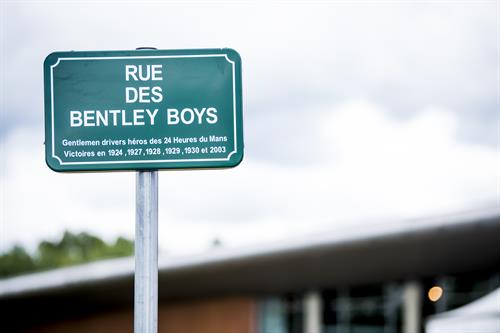CITY OF LE MANS RENAMES STREET ‘RUE DES BENTLEY BOYS’ AS BENTLEY CENTENARY CELEBRATIONS CONTINUE AT 24 HOURS OF LE MANS
The illustrious racing heritage of Bentley Motors is being honoured at this year’s 24 Hours of Le Mans – the world’s greatest motorsport event. Today, to mark the company’s Centenary and the brand’s close association with the race, the City of Le Mans renamed a street in honour of the indomitable ‘Bentley Boys’ who won five Le Mans 24-hour races between 1924 and 1930, and their successors who took the laurels in 2003.
On Saturday, 25 Bentley motor cars from across the marque’s last century will drive the Parade Lap at the beginning of this year’s race. They will be led by the all-new Flying Spur in its Global Dynamic debut, and the 2003 Le Mans race-winning EXP Speed 8.
A trackside display entitled ‘Bentley Through The Decades’ will also be a major highlight of the 87th running of the endurance race this weekend in France. Among the legendary Bentley models will be previous Le Mans race entries, including Bentley Motor’s Birkin Team Car; the legendary 1927 3-Litre No 2 Team Car from the 1930 race and the 1926 3-Litre Team Car No 8. EXP 2, the oldest surviving Bentley, will also be on display. Although it never raced at Le Mans, it is the most successful racing Bentley ever with 11 first and 7-second places to its name.
A new display on Bentley’s racing heritage will also open in the trackside 24 Hours of Le Mans Museum. Honouring Bentley’s six famous victories at the event the display will showcase a replica Speed 8 and Speed 6 and will run until September 2019.
Bentley Boys Honoured In Le Mans
Today, Bentley has been honoured by the City of Le Mans, which has renamed one of its major streets in memory of the company’s illustrious racing heritage. Rue de Laigne becomes ‘Rue des Bentley Boys’ paying homage to the group of wealthy young men who raced W.O. Bentley’s fast and dependable cars in the early 20th Century, and their 21st Century successors.
During the 1920s, Bentley enjoyed great success on the racetrack and also broke many speed records. It brought W.O.s new company front page recognition, none more so than the company’s first Le Mans victory in 1924.
W.O. worked with ‘Bentley Boy’ John Duff to prepare for the 1924 endurance race, travelling to France to watch his car take the company’s first chequered flag at Le Mans. The dashing Bentley Boys went on to win four more consecutive races from 1927 to 1930, dominating the Golden Era of Le Mans racing and delivering one of the sport’s greatest achievements.
After an absence of 73 years, Bentley returned to contest Le Mans in 2001 and won the race in 2003.
The Mayor of Le Mans, M.Stéphane Le Foll, led the re-naming ceremony and was joined by representatives of Auto Club de l’Ouest President M.Pierre Fillon, Bentley’s Director of Motorsport, Brian Gush, Bentley’s Head of Heritage Collection, Robin Peel and several current day ‘Bentley Boys’.
Global Dynamic Debut of All-New Flying Spur
Le Mans will host the global dynamic debut of the all-new Flying Spur on Saturday 15 June, as it demonstrates its sporting capabilities as Pace Car in the pre-race Parade Lap of the 24 Hours of Le Mans. Driven by Chris Craft, Bentley's Member of the Board for Sales, Marketing and Aftersales, it will lead more than 20 historic and current Bentley models from the company’s first 100 years around the historic racetrack in front of hundreds of thousands of motor racing fans from around the globe.
The all-new, All-Wheel Drive Flying Spur is an extraordinary Grand Tourer with unparalleled agility. Designed, engineered and handcrafted in Britain, the sports sedan sets new standards for both driving enjoyment and luxury.
It is the very first Bentley to feature All-Wheel Steering, enhancing both stability at cruising speeds and agility around town. The new, all-wheel drive Flying Spur is a ground-up development that sets a new benchmark for technology and craftsmanship in the luxury sector.
Two Special Le Mans Displays
Located on the track’s famous Dunlop Curve, a ‘Bentley Through The Decades’ static display on Friday (June 14) will feature a host of special Bentley models from the last 100 years. In addition to the EXP 2 and the 1927 Team Car, the display includes the Team Blower, an R-Type Continental, a Series 1 FS Continental and the EXP Speed 8 that won at Le Mans in 2003.
Before the start of the 87th 24 Hours of Le Mans, the prestigious Parade Lap on Saturday (June 15) will also be dominated by Bentley cars. Other models to join the all-new Flying Spur on the track circuit will include the EXP 2, the 1925 3 Litre ‘Speed’, the 4 ½ Blower, the 3 Litre Team Car, a Brooklands and a Continental GT3-R.
100 Years Of Extraordinary
From Le Mans victories, through to the incredibly powerful road cars of the modern era, all of Bentley’s extraordinary cars have innovation hand-built into them. July 10, 2019 marks Bentley’s 100th year - an extraordinary milestone achieved by only a few companies.
The Le Mans celebrations are just part of a year-long series of special activities, with celebrations at other events around the world. They will showcase Bentley’s motoring evolution over the last 100 years, highlighting its global success today and the exciting future of innovation ahead.
































